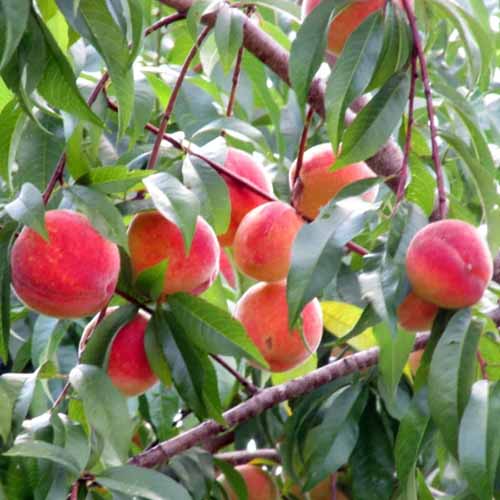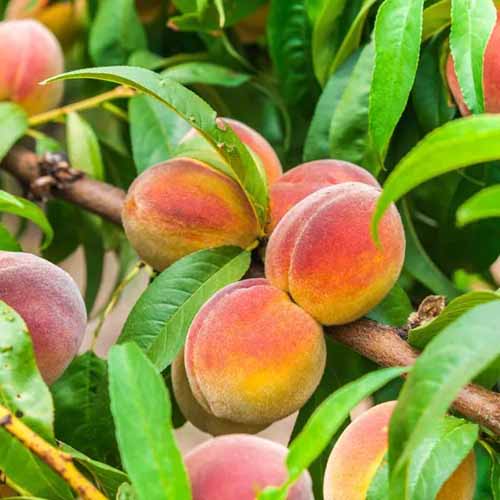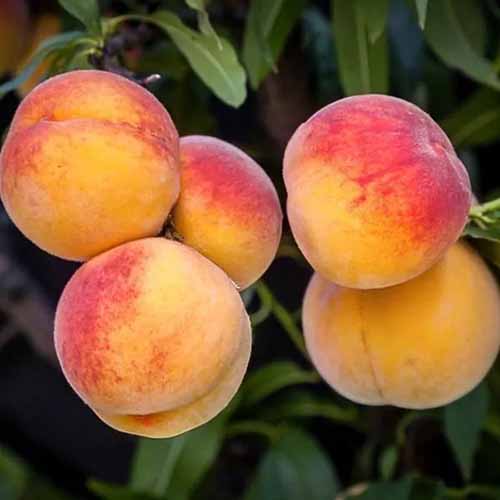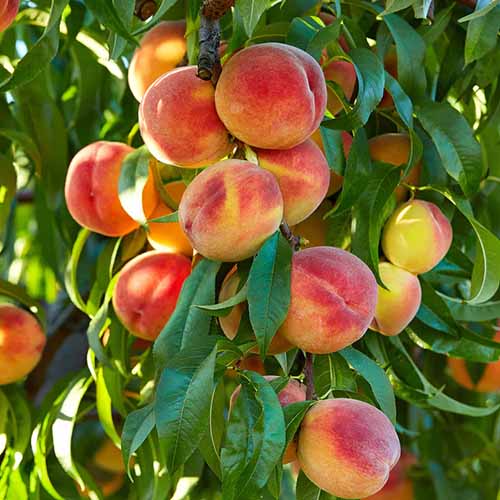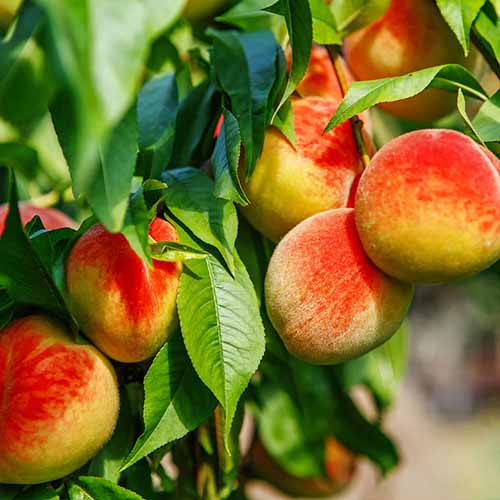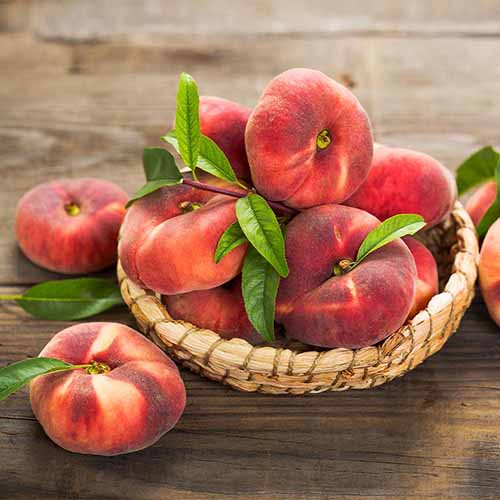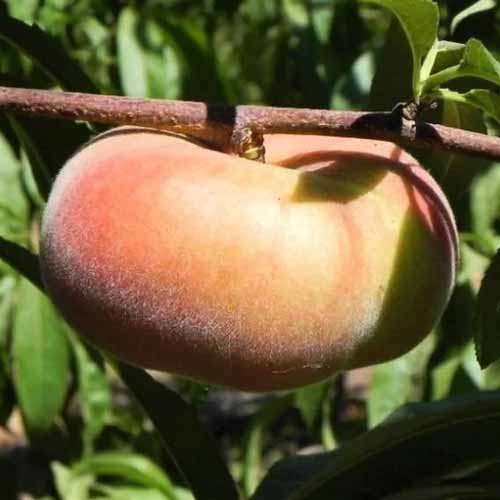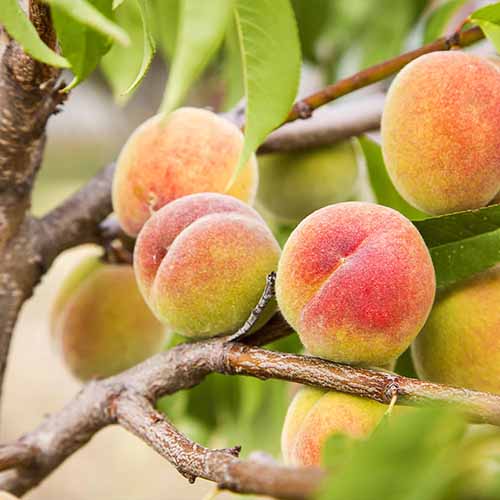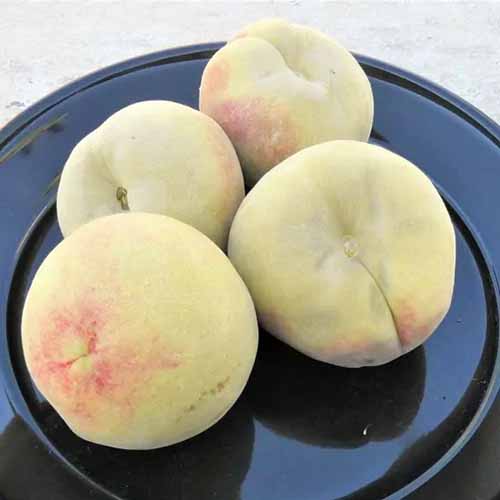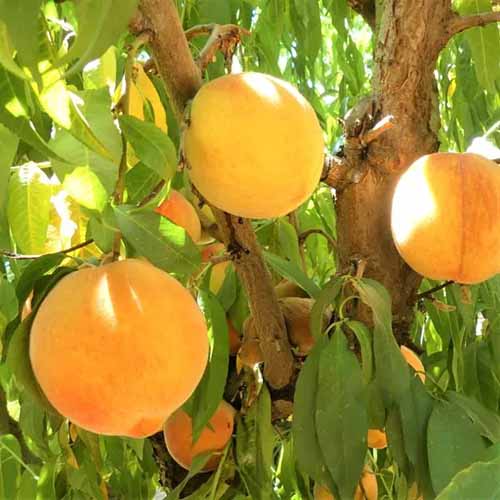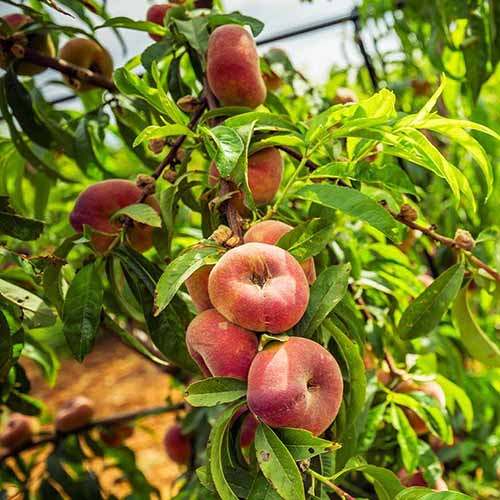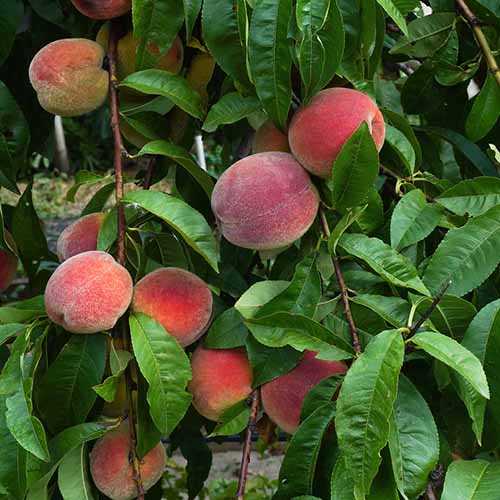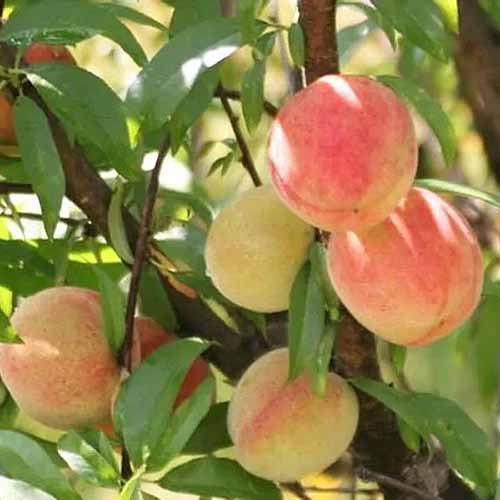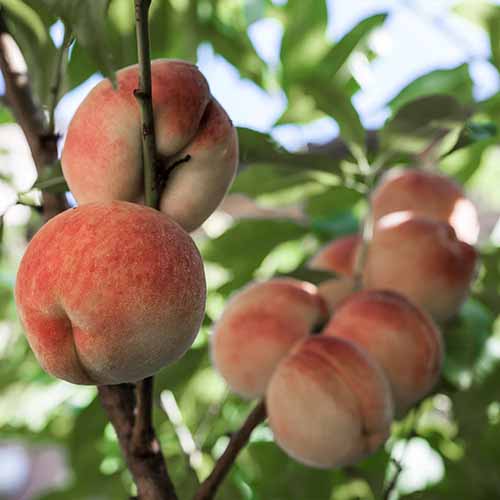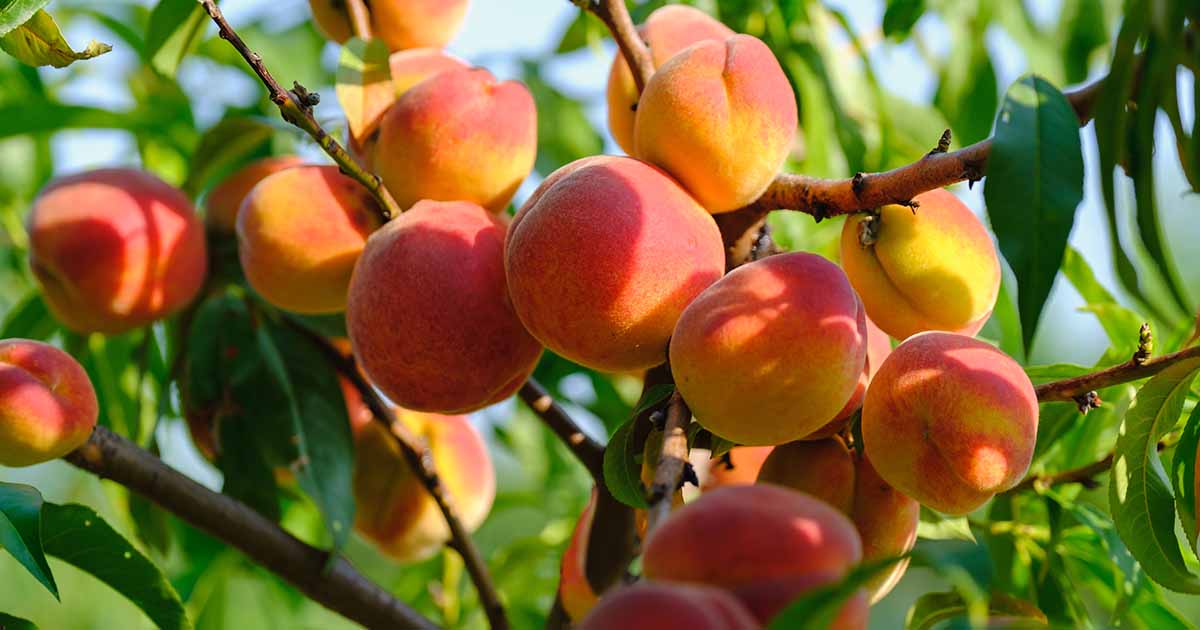
2. Belle of Georgia
This classic heirloom variety was developed in Georgia in the 1800s with blush red skin and firm white flesh with a hint of red.
Not only is the tree vigorous and tough, it also resists bacterial spot, and the buds can withstand some freeze, meaning you won’t necessarily lose your harvest if a late freeze happens.
Plant it on the south side of a brick or cement wall, and it’ll be even more immune to late freezes.
This self-fruitful tree is an early-mid season type that needs 800 to 850 chill hours and is hardy in Zones 5 to 8. Use the fruits for fresh eating or canning – they’re that versatile!
Find a four- to five-foot live plant from Perfect Plants and welcome this belle to your ball.
3. Bonanza
I live in a region that is, on paper, perfect for peaches.
I’m in the ideal USDA Hardiness Zone, with the perfect balance of chill hours and warm days. But our soggy, wet winters make peach growing an exercise in futility.
For those of us who dream of a real, home-grown peach, the only option is container growing, because we can cover our trees to protect them from the onslaught of rain or move them to a better growing location when needed.
If you have a short growing season, a limited amount of space, or experience soggy winters, ‘Bonanza’ is the peach you’ve been looking for.
‘Bonanza’ is a delicious dwarf midseason cultivar that produces piles of full-sized, yellow, freestone fruits, with a mild, sweet flavor, in Zones 5 to 9.
The tree is self-fruitful and only grows about six feet tall or shorter, earning it the nickname of “patio peach.” It also only needs a mere 250 chill hours.
Crave peaches but have a small growing area? Snag this versatile option at Planting Tree.
4. Bonfire
Another patio type, ‘Bonfire’ is a dwarf cultivar that tops out around six feet tall, though it can reach up to ten feet in ideal conditions in the ground.
Of course, the fruits are usually the star of the show, but this tree is primarily an ornamental with its bright pink and coral blossoms, and young purple leaves that mature to dark red and green. In the fall, the leaves turn golden yellow.
The small, yellow, freestone fruits aren’t fantastic fresh with a bright tartness mellowed a bit by honey, but they are extremely sweet and juicy when cooked or canned.
Grow this self-pollinating midseason plant in Zones 5 to 9, where there are 400 or more chill hours.
You can purchase a live tree in a #3 or #5 container from Nature Hills.
5. Contender
For those gardeners in cold climates from Zones 4 to 8, midseason ‘Contender’ should top your list.
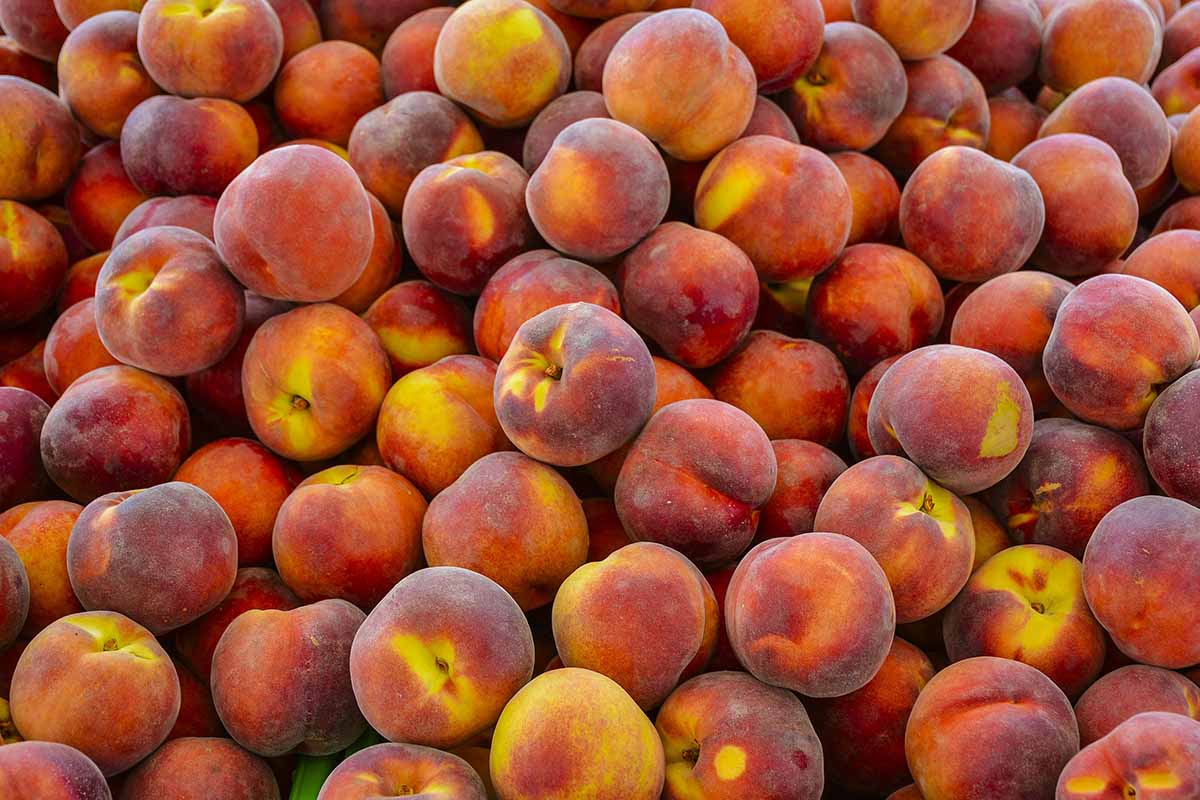
The yellow, freestone fruits are incredibly juicy and flavorful, with an excellent balance of sweet and tangy. They’re perfect both for fresh eating and cooking.
This variety needs 1,000 chill hours for the self-pollinating tree to produce fruits, but that shouldn’t be a problem for those with freezing climates.
Though it’s a recent addition to the market, having been bred at North Carolina State University in 1988, ‘Contender’ has proven to be a consistent producer and is also resistant to bacterial spot.
It blooms later in the year than most cultivars and the buds are somewhat tolerant of frosts, so a late freeze might not spell disaster.
Is ‘Contender’ a top contender in your book? Nature Hills carries live trees in #5 containers.
6. Early Amber
For a full-flavored yellow freestone fruit, you can’t do better than ‘Early Amber.’
The self-fruitful peach ripens early in June and only needs about 250 chill hours. Bred in Florida, it tolerates super hot, humid summers without wilting. She’s tougher than I am in that way.
This variety has become popular in the southwest because it can tolerate dry heat as well as moist heat.
Wherever you plant her in Zones 7 to 9, ‘Early Amber’ will give you large, juicy fruits.
It’s self-fertile, so those with limited space are in luck.
7. Elberta
The large fruits of ‘Elberta’ set the standard for yellow freestones. The state of Georgia is known for its sweet and extremely flavorful peaches, and ‘Elberta’ was the original.
It was bred in the 1870s by Georgia horticulturalist Samuel Henry Rumph and became the most popular cultivar of the early 1900s because the fruit can be shipped without being packed in ice, looks beautiful on display, and tastes phenomenal.
You could say it helped define Georgia peaches as the “best.”
This peach ripens in midseason with deep red skin and dark golden flesh. I’m more of a fan of more pungent peaches rather than the sugary sweet kinds, so ‘Elberta’ is always one I reach for.
The skin has a touch of bitterness to balance out the tangy sweetness inside.
It’s self-fertile, ripens in the midseason, and is a wildly popular classic that can be used cooked or fresh. Give it 800 chill hours, and it can grow anywhere in Zones 5 to 9.
If you’re dreaming of the firm flesh, bold flavor, and peach pies to the sky, snag a live tree in a #3 or #5 container from Nature Hills Nursery.
8. Flordaking
Impatient growers take note: ‘Flordaking’ is one of the earliest peaches to ripen, ready for eating in May.
The large fruits have firm yellow flesh wrapped in orange-red skin. They’re semi-clingstone and extremely sweet.
The tree needs about 500 chill hours and was bred by the University of Florida to thrive in Zones 6 to 9.
It’s self-fertile, so no need for a friend, but the deep pink blossoms will pollinate any other peaches, nectarines, or plums that are growing nearby.
It has become a hugely popular cultivar for Gulf Coast growers, in part because it tolerates hot, humid weather, but also because it’s resistant to bacterial spot.
Bring home a four- to five-foot tree from Perfect Plants and enjoy the bounty.
9. Frost Proof
The name says it all. Frost is the peach-growers’ arch-nemesis. Late frosts can decimate the blossoms, which means no fruits that year. It’s devastating.
‘Frost Proof,’ also known as ‘Frost,’ has you covered. Not only does it have marvelous, tangy, yellow-fleshed, freestone fruits, but it produces a ton of them.
The tree is also resistant to bacterial spot and leaf curl. It can tolerate some drought, too. It blossoms out a bit later than other types and the flowers can handle a light frost without failing.
Harvest in the midseason in Zones 5 to 9 after 700 chilling hours.
Make one (or two or three) yours from Fast Growing Trees.
10. Galaxy
‘Galaxy’ produces adorable, semi-clingstone peaches that are round and slightly flattened, known as donut shape, named for the pastry they resemble.
At six ounces each, these are the largest donut types you can grow, and their creamy orange skins are so beautiful that they deserve a spot front-and-center in a fruit bowl.
The white flesh is tender and sweet with no tang or bitterness to mar the experience.
Developed by the USDA research station in San Joaquin Valley, California, the tree needs 450 chill hours and fruits ripen midseason in Zones 5 to 10.
Not that it’s a dealbreaker if a peach tree is kind of gangly, but ‘Galaxy’ could almost be an ornamental with its snow-white flowers and compact, weeping, umbrella-like canopy.
Even though the semi-dwarf tree tops out at just 15 feet, it still produces up to 50 pounds of fruit and doesn’t need a pollinator.
For an out-of-this-world treat, grab yourself a ‘Galaxy’ at Fast Growing Trees.
11. Hale Haven
‘Hale Haven,’ sometimes written ‘Halehaven,’ is a cross between ‘J.H. Hale’ and ‘South Haven.’
It produces medium to large yellow freestone peaches with bright red skins. They have a bold flavor with low acidity and need 900 chill hours for a midseason harvest.
The fruits on this self-pollinating cultivar are some of the best for canning, with sweet, firm, rich flesh. Give the 15-foot-tall tree 900 chill hours in Zones 5 to 8, and you’ll be off to the races.
Find trees available at Nature Hills Nursery in #5 containers.
12. Newhaven
‘Newhaven’ is a freestone type closely related to ‘Redhaven,’ the standard by which all other early-season yellow peaches are judged.
‘Newhaven’ has slightly smaller fruits that are a touch sweeter with less acid, plus it’s more resistant to bacterial leaf spot. Freeze them, can them, or devour them raw, the early fruits are juicy and delectable.
This cultivar was bred by Michigan State University and was introduced to market in 1979.
Since then, the 15 foot trees have found popularity both for their fruits and the bright pink blossoms. ‘Newhaven’ requires 950 chill hours and is self-fertile. Grow it in Zones 5 to 9.
13. Pink Halo
‘Pink Halo’ fruits are almost too pretty to eat. The white flesh has just a hint of blush and a smooth, firm texture.
The flavor of these donut-shaped peaches is sweet with a bit of tang.
The self-pollinating 15-foot-tree doesn’t require a ton of chill hours – only about 500, but will produce an abundant midseason harvest.
The rose pink blossoms in the spring are pretty and the sweet fruits are a reliable summer treat.
If you’d like to add ‘Pink Halo’ to your garden, visit Nature Hills for a live plant in a #3 container.
14. Polly
‘Polly’ is extremely cold-hardy. It’s extremely tolerant of freezing temperatures, growing in Zones 4 to 9, so even those in extremely cold regions can enjoy the freestone, white-skinned fruits.
This Iowa heirloom has extremely sweet, soft flesh and a pretty blush skin. The flesh is so delicate that it practically falls away from the stone.
Give this self-fruitful, midseason, disease-resistant cultivar 1,000 chill hours.
Fast Growing Trees carries pretty ‘Polly,’ (aka ‘Polly White’) with its pearl pink flowers.
15. Redskin
The firm flesh of ‘Redskin’ is beautiful. It’s bright yellow with heavy blush red throughout, wrapped in dark red skin.
The freestone fruit of this mid-season, self-pollinating type is perfect for canning and develops after 850 chill hours in Zones 6 to 9.
This cultivar is heavily productive, and the pretty pink blossoms will resist late frosts. It truly shows all the best of its parents, ‘Red Haven’ and ‘Eberta.’
Grab a tree in three- to four-, four- to five-, five- to six-, or six- to seven-foot heights at Fast Growing Trees.
16. Salish Summer
Blooming later in the spring after about 700 chill hours in Zones 5 to 9, the blush skin of this semi-freestone type wraps around pinkish-white flesh. The fruit has a sweet, tangy flavor that melts in your mouth.
This self-fruitful, mid-season cultivar was bred by Washington State University at their famous Mount Vernon Station, and it was named by Dr. Bob Norton and Carol Norton after the native term for the Puget Sound.
It’s resistant to leaf curl, which makes ‘Salish Summer’ a good option for those in wet regions who dream of growing their own peaches.
You can find four- to five-foot-tall trees in #3 containers at Nature Hills Nursery.
17. Santa Barbara
This gorgeous peach has red skin and yellow flesh that is dark red around the freestone pit.
It needs just 300 chill hours, which makes it popular among those in warmer regions in Zones 8 to 10.
The fruits ripen in midseason and are a juicy, sweet treat that will melt on your tongue.
Self-fruitful ‘Santa Barbara’ was bred from a bud sport of ‘Ventura.’
The tree has branches that grow out and slightly downwards rather than strongly upright, which makes it easier to harvest the fruits.
This shape is a bit of a liability if you live somewhere with heavy snow, though, because the snow can build up on the branches and weigh them down, causing them to break.
You can find ‘Santa Barbara’ available from Nature Hills Nursery.
18. Saturn
Self-fruitful ‘Saturn’ is the ultimate dual-purpose fruit tree. It’s gorgeous when robed in the large, double, dark pink blossoms in the spring.
Then, in midseason, along come the juicy, sweet, freestone fruits with yellow flesh and blush skin.
‘Saturn’ originated in China and was introduced by Rutgers and Stark Bro’s in the 1990s.
It quickly became a favorite in California, in part because it only needs about 250 chill hours in Zones 5 to 9. It’s also resistant to bacterial spot.
The term “Saturn” is sometimes used to describe any squat peach, but this self-pollinating marvel is a true cultivar.
You can find ‘Saturn’ available at Fast Growing Trees.
19. Scarlet Prince
Smack dab in the middle of the peach season, along comes the deep red-skinned fruits of ‘Scarlet Prince.’
Inside, the freestone fruits have bright yellow flesh that melts in your mouth with a sweet, tangy flavor.
It stays fairly petite at under 15 feet tall and resists bacterial spot. It’s also cold-tolerant, growing in Zones 5 to 9 with over 850 chill hours.
It starts fruiting after just one or two years, and is draped in pretty pink flowers in the spring.
Bring his Royal Highness home in a five- to six-foot height from My Perfect Plants.
20. Tropic Snow
‘Tropic Snow’ is a must-have if you live in a warm area and want to enjoy sweet, white peaches.
It’s self-fruitful, and produces fruits with blush skin that has made it a popular freestone option for selling at farmer’s markets.
Introduced in 1986 as a collaboration between the University of Florida and Texas A&M University, it needs a mere 200 chill hours.
The only bad thing about this cultivar is that it won’t thrive in chilly areas. Same, girl.
It only thrives in Zones 8 to 10, so those lucky folks are the ones who get to enjoy ‘Tropic Snow’ fresh off the tree.
The fragrant pink blooms are showy and beautiful, and are some of my favorite edible flowers.
Nature Hills Nursery will take you to the tropics with a live plant in a #3 or #5 container.
21. White Lady
What kind of peach do you prefer? Do you prefer one that has a creamy mouthfeel and a sweet, sugary flavor?
Are you looking for a tree small enough to harvest easily from? Then you have found your cultivar.
Self-pollinating ‘White Lady’ fruits in the early season after about 900 chill hours in Zones 5 to 9, and produces freestone, medium-sized, white-fleshed peaches wrapped in contrasting red skin.
The peaches are purely sweet with low acid on a plant that only reaches 12 to 15 feet tall.
Fast Growing Trees carries this cultivar in a variety of sizes.
Your Perfect Peach Is Out There
There are peach options for those in cold regions, hot regions, and everything in between.
Whether you like them tangy or sugar-sweet, the quintessential fruits of summer are yours for the plucking.
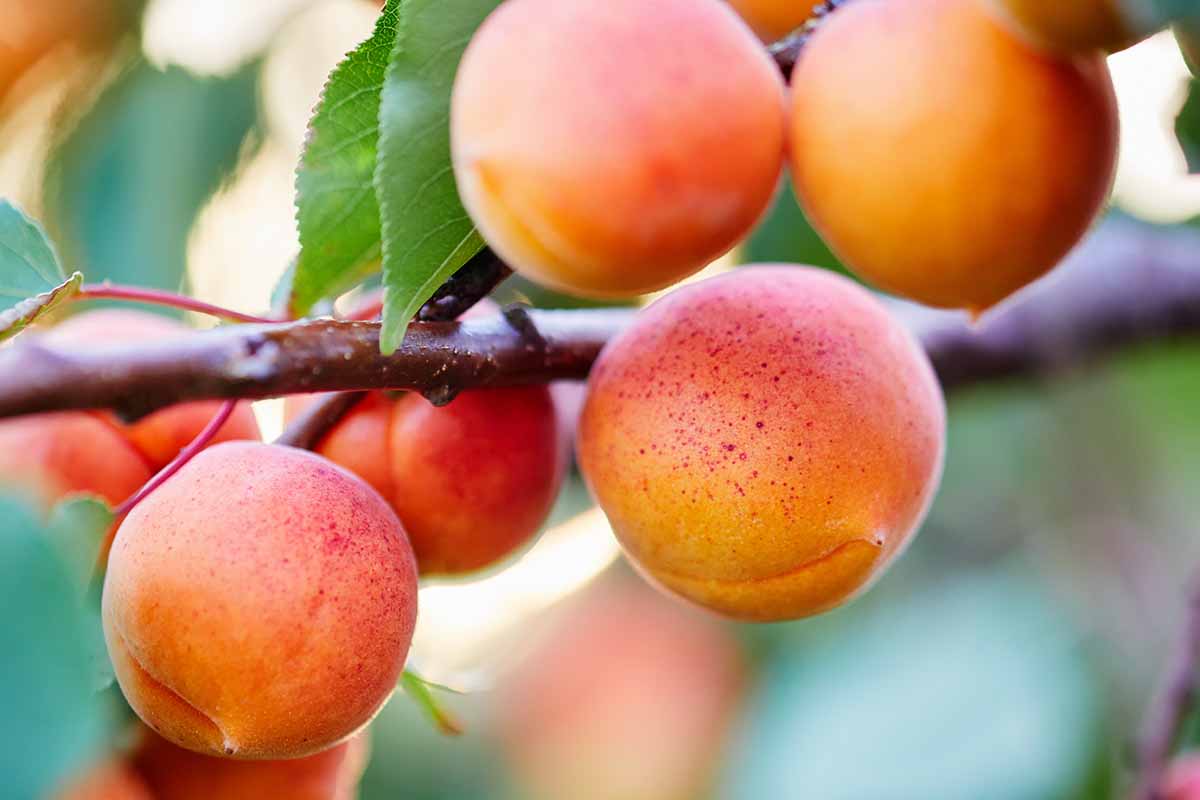
Which one of these are you planning to grow? Or, if we missed your absolute favorite, let us know in the comments.
Now that you’ve picked your ideal tree, you’ll want more information about growing peaches in your garden. Have a read of these guides next:
